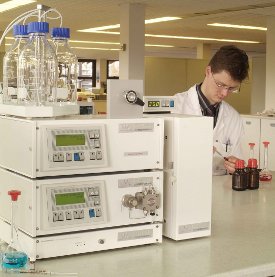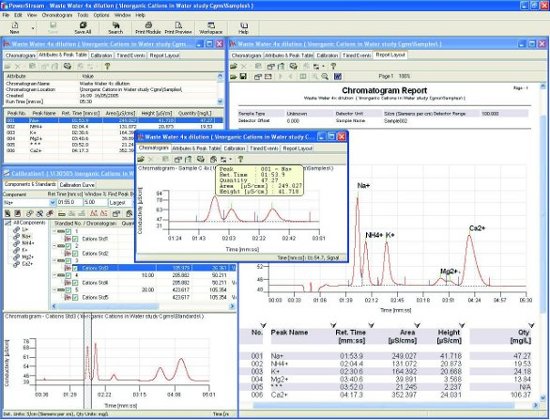Featured Article

Please check out our Ion Chromatography sections for more information or to find manufacturers that sell these products
Ion chromatography systems are used to separate charged particles from a liquid and measure their concentration with sensitivity down to parts per billion. Ion chromatography (IC) analytes include anions such as fluoride, chloride, nitrate, nitrite, and sulfate; cations such as lithium, sodium, ammonium, potassium, calcium, and magnesium; organic salts such as carboxylic acids and amine groups; and proteins.
IC systems are used in a range of industries, including environmental, manufacturing, food, pharmaceuticals, and chemicals. IC is frequently used for water chemistry analysis, measuring contaminants in drinking water or water for industrial purposes. Other applications include:
- Measuring the impact of chemical activity on soil samples
- Monitoring salt, sugar, or nitrate levels in foods and beverages
- Separating proteins according to charge.
Overview of an ion chromatography system
 Figure 1 – Ion chromatography system. (Figures 1 and 2 used with kind permission of Cecil Instruments [Cambridge, U.K.]).
Figure 1 – Ion chromatography system. (Figures 1 and 2 used with kind permission of Cecil Instruments [Cambridge, U.K.]).A typical IC analysis proceeds as follows. A liquid sample is prepared by hand or using an autosampler. For cation detection, the sample flows through a column containing negatively charged resin beads. Any cations in the sample bind to the beads. A positively charged eluent passes through the column, competitively displacing the bound ions. The varying strength of association of the cationic species for the beads leads to different retention times along the column, leading to time-dependent detection of different species within a sample.
The ions and eluent pass through a suppressor to neutralize the charged eluent. The ions are detected using a charge detector and the data are analyzed and presented to the chemist.
For anion detection, the process is the same, but a negatively charged eluent is used with a positively charged stationary phase.
The capabilities of an IC system are differentiated on speed, selectivity, sensitivity, and capacity. Components of an IC system are: 1) autosampler, 2) eluent generation and recycling, 3) column head, 4) column technology, 5) suppression, 6) detection, and 7) chromatography data system (see detailed sections below and Table 1). A typical IC system is shown in Figure 1.
Table 1 - Ion chromatography system purchasing considerations

Autosamplers prepare liquid samples, reducing the risk of contamination and increasing sample consistency. Autosamplers vary in the number of samples and range of sample volume.
For example, AutoQuest from Cecil Instruments offers 50 or 100 sample positions. Sample volumes can be prepared from 5 μL to 2 mL. By contrast, the 889 IC Sample Center from Metrohm (Riverview, FL) can be used for injection volumes of 1 to 100 μL in 1-μL increments.
Some manufacturers provide a range of autosamplers. Metrohm offers different units for basic or advanced sample handling and loading, plus Soliprep for solid sample preparation and loading.
Eluent generation and recycling
The choice of eluent is the main factor affecting the speed of the system. Charged eluent can be purchased and added to the system, but this risks the introduction of contaminants. For example, NaOH solutions for anion separation are easily contaminated by carbonate ions from the absorption of atmospheric CO2.
Most IC systems include an eluent generator that charges pure deionized water. The eluent is delivered directly to the column head, removing any risk of contamination. Eluent generation also makes it possible to recycle the eluent, decreasing the maintenance overhead for the system.
Column head
The column head pumps the sample and the eluent through the column. The choice of pump head depends on the column technology used. For example, the ICS-5000 SP Single Pump from Thermo Fisher Dionex (Sunnyvale, CA) can be configured with either capillary or analytical pump heads to support capillary, microbore, standard bore, or semipreparative applications. Analytical pumps offer the option of mechanical gradients yielding linear, concave, and convex gradients.
Column technology
The column technology affects the selectivity of the system, so the choice of column depends on the ions to be detected. The wide range of column technology available reflects the range of applications of IC systems.
Because eluents and samples are often corrosive, all components of an IC system must be inert. Therefore, polymeric beads are used to form the charged matrix through which the sample and eluent are pumped. The size and structure of the beads affect the speed and sensitivity of the system.
The system flow and pressure vary widely, depending on the choice of column. Maximum pressure can range from 2.5 to 34 MPa. Column flow velocities are on the order of mL/min.
Suppression
Suppression is a vital component of IC systems. Suppression neutralizes the eluent to make it possible to detect the charges of the ions of interest. Suppressor choice depends on the eluent used, whether organic solvents are used, and the type of ions being detected. The capacity of the system is dependent on the suppressor.
Most systems use electronic suppression, which can be employed on a continuous basis when the eluent has been generated from water. Compare the performance capabilities of Dionex suppressors.
Detection
The charge detector consists of a cell with an alternating current. The charged particles are attracted to the anode or the cathode. The charge flux is measured over time and the data are fed to software for results analysis.
Charge detection is one of the simplest components of an IC system and you can expect it to be long lasting.
Chromatography data system
The final stage in an IC system is the output. Chromatogram software analyzes and presents the results. Each manufacturer has its own software that varies in presentation style and additional capabilities. Figure 2 shows a typical display from PowerStream software from Cecil Instruments.
 Figure 2 – A typical display from Cecil Instrument’s PowerStream software, showing a wastewater cation analysis with a superimposed portion of the chromatogram highlighting sodium.
Figure 2 – A typical display from Cecil Instrument’s PowerStream software, showing a wastewater cation analysis with a superimposed portion of the chromatogram highlighting sodium.Metrohm columns include built-in chips that monitor parameters such as pump flow, pressure, number of injections, and working life of the column itself. These data are accessed through Metrohm MagIC Net™ software. Users can also define service intervals, expiration dates, and GLP test intervals. The software includes security configurations and an audit trail.
Recent developments
Ion chromatography is a modern technique that is still undergoing technical advances. Recent developments include high-pressure capillary systems for IC and the combination of IC with mass spectrometry (MS) for detection.
Capillary systems
Capillary systems operate using narrow columns at high pressure with low volumes of sample and eluent, resulting in faster separation times. Typical column diameters are less than 1 mm, with flow rates of 10 μL/min. Capillary systems can be operated continuously for longer than conventional systems, removing the need to balance the column and suppressor before use. Capillary systems provide improved separation efficiency over conventional IC systems and are particularly advantageous for applications where the quantity of sample is limited. Dionex released the ICS-5000 in March 2012, bringing high-pressure capability to its capillary ion chromatography system.
IC-MS systems
IC-MS systems are made possible when charged water is used as the eluent and is subsequently removed from the system. Mass spectrometry can be used in conjunction with charge detection, leading to very sensitive and selective detection capabilities.
For more information on ion chromatography systems, please visit www.labcompare.com.
Katriona Scoffin, B.Sc., is a freelance science writer; e-mail: [email protected].
Please check out our Ion Chromatography sections for more information or to find manufacturers that sell these products